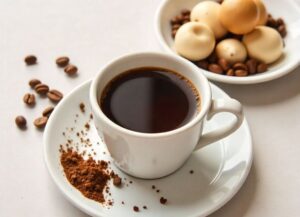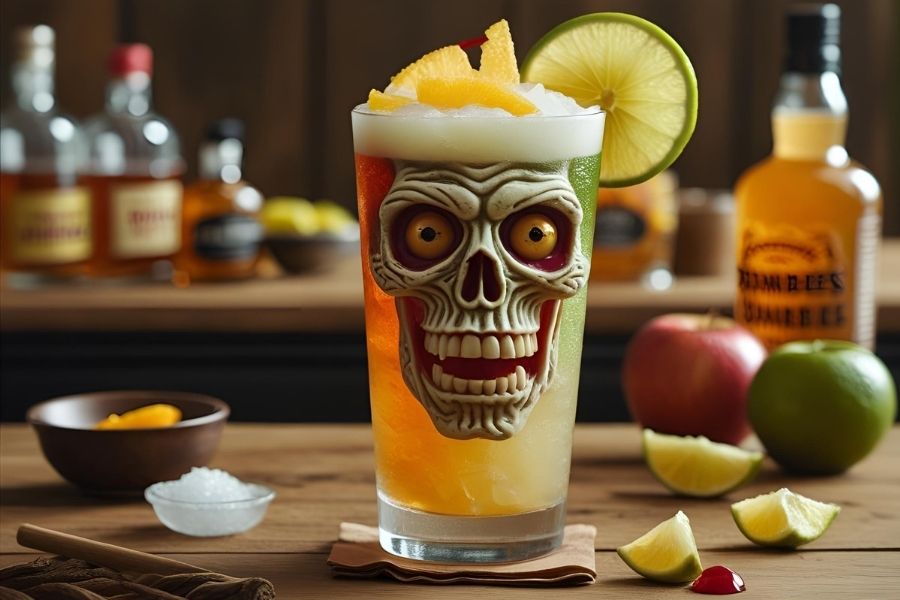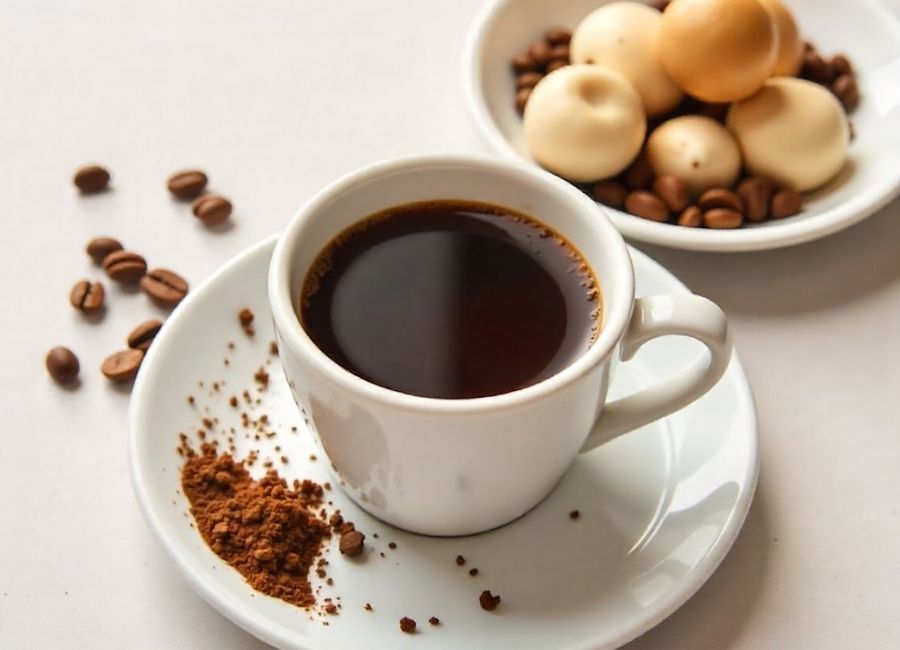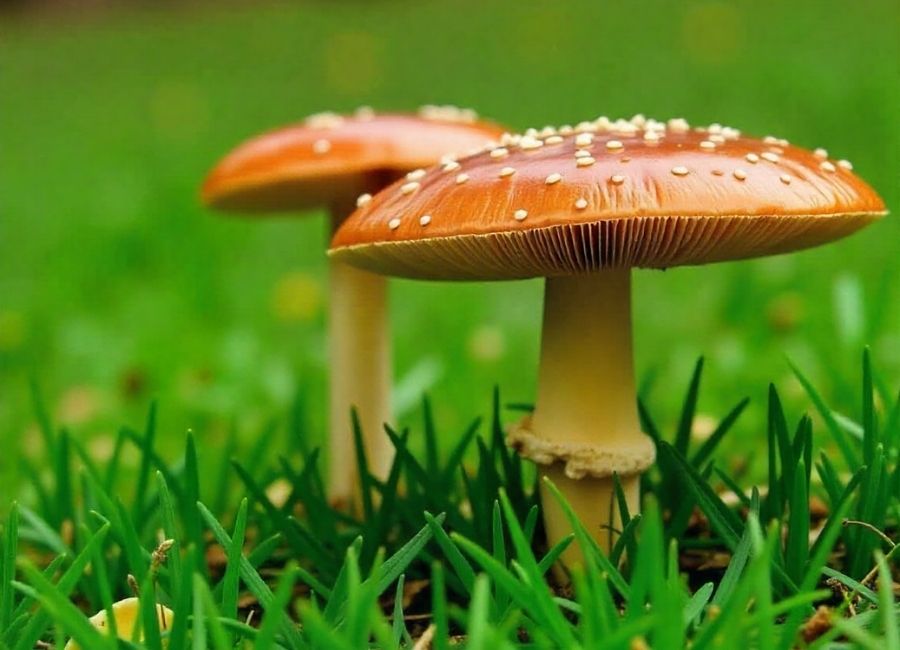The Applebee’s Zombie drink has earned its place among the most notorious cocktails in casual dining history. This potent concoction, inspired by the classic tiki bar creation, packs multiple types of rum into a single glass that’s both dangerously delicious and deceptively strong. Unlike its blue cousin, the Shark Bowl, the Zombie brings tropical flavors with a darker, more mysterious appearance that hints at its legendary strength.
Created by Donn Beach in the 1930s, the Zombie cocktail became famous for its ability to render drinkers nearly unconscious after just one serving. Applebee’s version maintains this reputation while adapting the recipe for mainstream appeal. The restaurant’s interpretation focuses on accessibility and consistency, making it possible for home bartenders to recreate this legendary drink with readily available ingredients.
Understanding the Zombie’s ingredient profile is crucial for anyone attempting to recreate this iconic cocktail. Each component serves a specific purpose in creating the perfect balance of fruit flavors and rum complexity that makes this drink both irresistible and infamous. The key lies not just in having the right ingredients, but in understanding how they work together to create a cocktail that’s greater than the sum of its parts.
The drink’s popularity extends beyond its strength. The Zombie represents a connection to tiki culture and exotic escapism that appeals to drinkers seeking adventure in their glass. This psychological element, combined with the cocktail’s impressive alcohol content, creates an experience that’s both nostalgic and thrilling.
Understanding the Zombie Cocktail Legacy
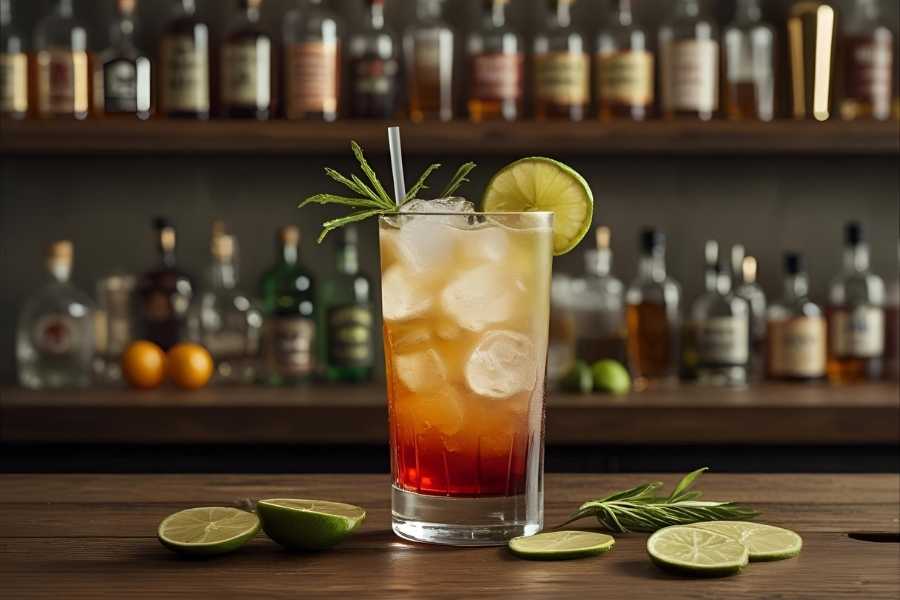
The Zombie cocktail carries a rich history that adds depth to every sip. Donn Beach, the original creator, reportedly limited customers to two Zombies per visit due to the drink’s potency. This restriction became part of the cocktail’s legend, establishing its reputation as a drink that commands respect and caution.
Applebee’s adaptation maintains the spirit of the original while making it more approachable for casual diners. The restaurant version typically contains less alcohol than traditional tiki bar recipes, though it remains significantly stronger than most standard cocktails. This balance allows diners to enjoy the Zombie experience without the extreme effects that made the original famous.
The drink’s name comes from its alleged ability to turn drinkers into zombie-like states of intoxication. While this reputation is somewhat exaggerated, the Zombie does contain enough alcohol to impair judgment and coordination significantly. This potency demands responsible consumption and careful attention to serving sizes.
Modern interpretations of the Zombie have evolved to include various fruit juices and flavor enhancers that weren’t available during the original era. These additions help balance the strong rum base while maintaining the tropical character that defines the drink’s identity.
Essential Zombie Drink Ingredients
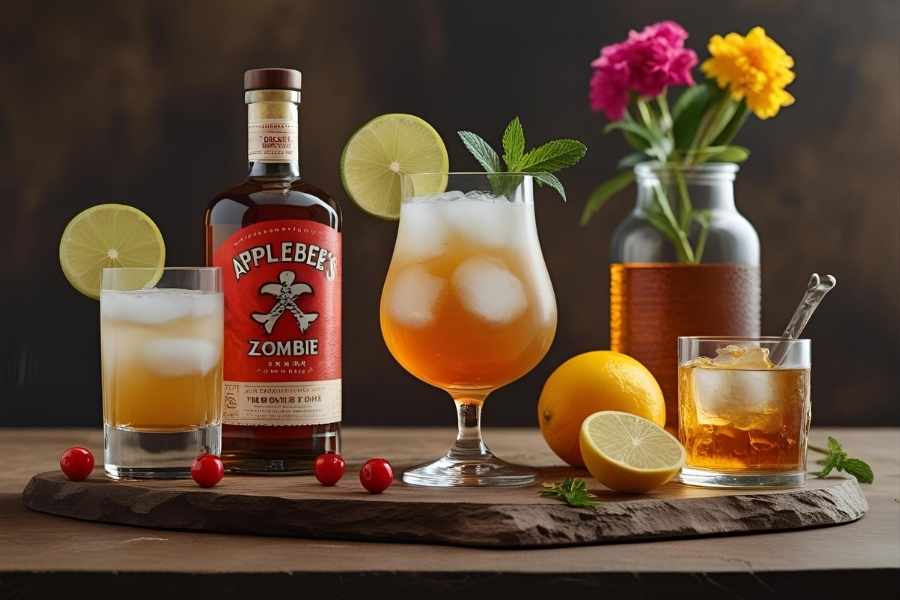
Creating an authentic Applebee’ s-style Zombie requires specific ingredients that work in harmony to achieve the desired flavor profile and strength. The foundation of any Zombie cocktail lies in its rum selection, which forms the backbone of the entire drink.
The Rum Foundation
Light rum provides the clean alcohol base that carries the other flavors without overwhelming them. Choose a quality white rum that’s smooth enough to drink neat, as harsh rums will create an unpleasant burning sensation that detracts from the overall experience. Bacardi Superior or similar mid-range options work excellently for this purpose.
Dark rum adds complexity and depth to the flavor profile. The molasses notes and barrel aging contribute richness that balances the bright fruit flavors. Captain Morgan Original Spiced Rum or Myers’s Dark Rum provide the necessary character without being overpowering. The dark rum should complement, not dominate, the other ingredients.
Coconut rum brings tropical sweetness and exotic flavor notes that define the Zombie’s island character. Malibu or Captain Morgan Coconut Rum work well, though any quality coconut rum will suffice. This ingredient bridges the gap between the base rums and the fruit mixers, creating a cohesive flavor profile.
Some recipes include 151-proof rum as a float, adding extra potency and visual drama. Bacardi 151, when available, or any high-proof rum can serve this purpose. However, this addition should be used sparingly and only by experienced drinkers who understand the implications of such high alcohol content.
Fruit Juices and Mixers
Pineapple juice forms the primary mixer, providing tropical sweetness and acidity that balances the rum’s strength. Fresh pineapple juice produces superior results, though high-quality bottled juice serves as an acceptable substitute. The juice should be cold and well-strained to prevent pulp from affecting the drink’s texture.
Orange juice adds citrus brightness and additional vitamin C that helps mask the alcohol burn. Fresh-squeezed orange juice provides the best flavor, but premium bottled juice works adequately. Avoid juice with excessive pulp, as it can create an unpleasant texture in the finished cocktail.
Cranberry juice contributes tartness and the Zombie’s characteristic reddish color. Use 100% cranberry juice rather than cranberry cocktail for better flavor control and less artificial sweetness. The cranberry juice should be added gradually to achieve the desired color intensity without overwhelming the other fruit flavors.
Lime juice provides essential acidity that brightens all the other flavors and prevents the drink from becoming overly sweet. Fresh lime juice is mandatory for optimal results, as bottled lime juice lacks the bright, sharp character necessary for proper balance. Rose’s lime juice can work in emergencies but produces inferior results.
Flavor Enhancers and Syrups
Grenadine adds sweetness and enhances the drink’s red color. Quality grenadine made from pomegranate juice produces better results than corn syrup-based alternatives. The grenadine should be added carefully to avoid overpowering the other fruit flavors.
Simple syrup or orgeat syrup can be used to adjust sweetness levels according to taste preferences. Orgeat, an almond-based syrup, adds complexity and authenticity to the recipe, though simple syrup works as a more accessible substitute.
Some variations include passion fruit syrup or apricot brandy for additional tropical complexity. These ingredients should be used sparingly to avoid creating a muddy flavor profile that lacks definition.
Complete Applebee’s Zombie Recipe
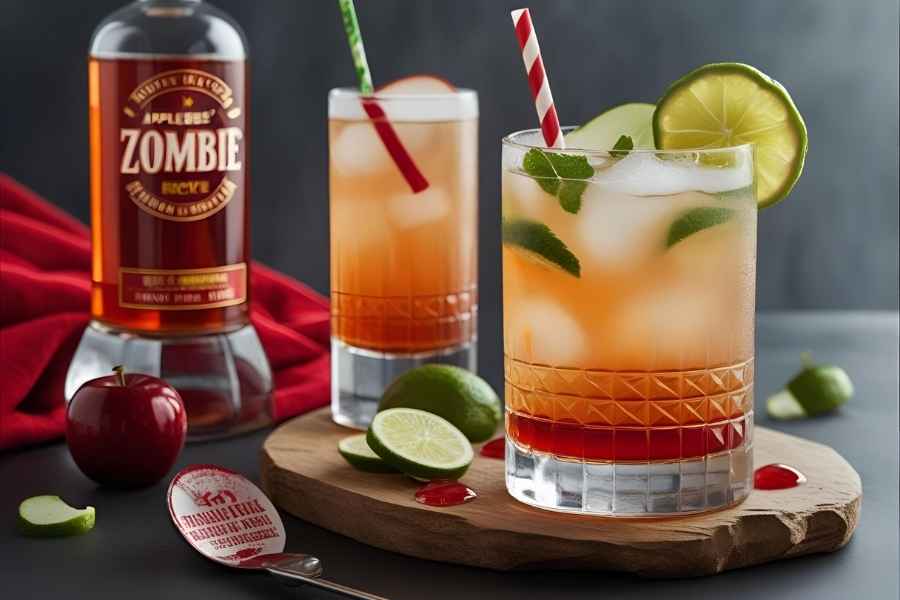
This recipe creates one serving of the Applebee’ s-style Zombie cocktail. Due to its high alcohol content, this drink should be consumed slowly and responsibly.
Ingredients
- 1 oz light rum
- 1 oz dark rum
- 1 oz coconut rum
- ½ oz 151-proof rum (optional, for floating)
- 3 oz pineapple juice
- 1 oz orange juice
- 1 oz cranberry juice
- ½ oz fresh lime juice
- ½ oz grenadine
- ¼ oz simple syrup (adjust to taste)
- 1 cup crushed ice
- Garnishes: orange slice, maraschino cherry, pineapple wedge
Preparation Instructions
Begin by chilling all ingredients and glassware. Use a hurricane glass or a large cocktail glass that can accommodate the drink’s volume and garnishes. Fill the glass with crushed ice, packing it lightly to create the proper texture and temperature control.
In a cocktail shaker filled with ice, combine the light rum, dark rum, coconut rum, pineapple juice, orange juice, cranberry juice, lime juice, grenadine, and simple syrup. Shake vigorously for 15-20 seconds to ensure proper mixing and chilling.
Strain the mixture over the crushed ice in your prepared glass. The drink should have a beautiful reddish-orange color with good clarity. If using 151-proof rum, carefully float it on top by pouring slowly over the back of a bar spoon.
Add garnishes by threading the orange slice and cherry onto a cocktail pick, then placing it across the rim of the glass. Add the pineapple wedge to the side of the glass for additional visual appeal and aromatic enhancement.
Professional Mixing Techniques
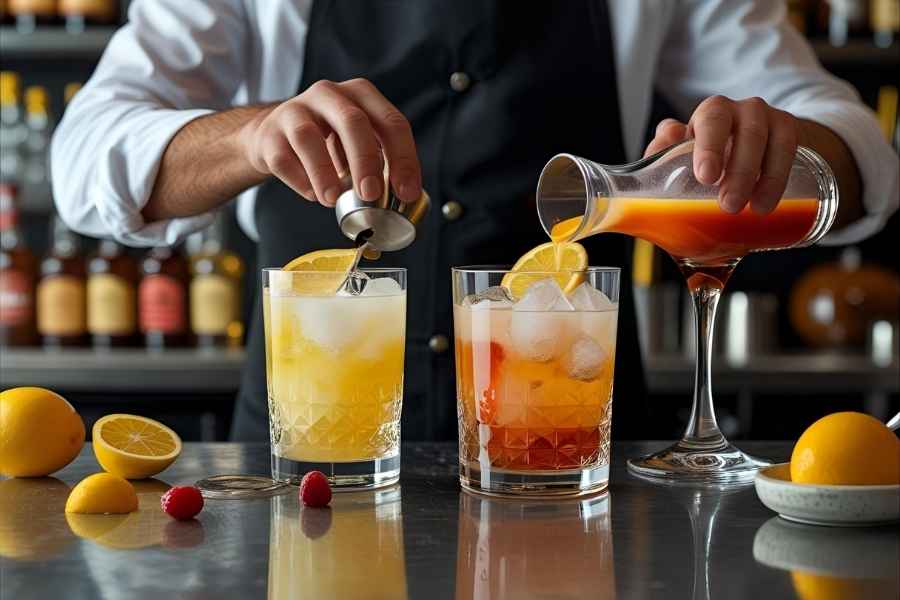
Achieving restaurant-quality results requires attention to mixing techniques that maximize flavor integration while maintaining the drink’s visual appeal. The order of operations significantly impacts the final product’s taste and appearance.
Proper Shaking Method
Use a Boston shaker or cobbler shaker filled with fresh ice. The ice should be clean and free from freezer odors that could affect the drink’s taste. Shake with firm, controlled movements for exactly 15-20 seconds. Over-shaking dilutes the drink, while under-shaking fails to integrate the ingredients properly.
The shaking motion should be horizontal rather than vertical, creating maximum agitation without excessive ice breakage. Broken ice creates unwanted dilution and negatively affects the drink’s texture.
Straining Technique
Double strain the mixture through both the shaker strainer and a fine-mesh strainer to remove ice chips and pulp. This technique ensures a smooth texture that’s essential for proper presentation and drinking experience.
Pour steadily and confidently to avoid splashing and maintain the drink’s visual appeal. The stream should be controlled but not hesitant, allowing the ingredients to support their integration.
Ice Considerations
Crushed ice is traditional for Zombie cocktails, as it provides better temperature control and creates the proper dilution rate. If crushed ice isn’t available, pulse regular ice cubes in a blender until they reach the appropriate consistency.
The ice should fill approximately two-thirds of the glass, leaving room for the liquid and garnishes. Too much ice crowds the drink, while too little fails to provide adequate chilling.
Flavor Variations and Adaptations
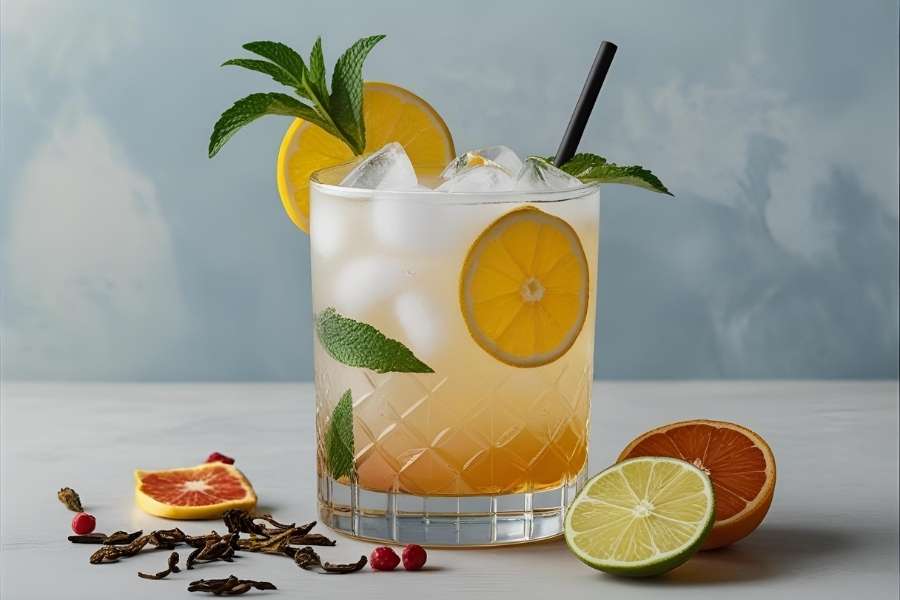
The basic Zombie recipe serves as a foundation for creative variations that can accommodate different tastes and preferences. Understanding how to modify the recipe allows for personalization while maintaining the drink’s essential character.
Strength Adjustments
For a milder version suitable for casual consumption, reduce each rum portion by 25% and increase the fruit juice proportions accordingly. This modification maintains the flavor profile while creating a more manageable alcohol content.
Conversely, traditional tiki enthusiasts can increase the rum content and add the 151-proof float for a more authentic, potent experience. This approach should only be attempted by experienced drinkers who understand their limits.
Fruit Flavor Modifications
Mango juice can substitute for half the pineapple juice, creating a richer tropical flavor with less acidity. This variation appeals to those who find traditional Zombies too tart.
Passion fruit juice or syrup adds exotic complexity and enhances the drink’s tropical character. Use sparingly, as passion fruit’s intense flavor can easily overpower other ingredients.
Coconut cream can be added in small amounts to create a richer, more dessert-like texture. This modification works particularly well for special occasions or when serving the drink as a treat rather than a casual cocktail.
Presentation Alternatives
While hurricane glasses are traditional, the Zombie works well in other presentations. Large rocks glasses create a more casual appearance, while tiki mugs enhance the exotic theme and provide better insulation.
Frozen versions can be created by blending all ingredients with ice, though this significantly changes the drink’s character and dilution rate. Frozen Zombies appeal to those who prefer slushy textures but lose some of the original’s sophistication.
Garnish Selection and Presentation
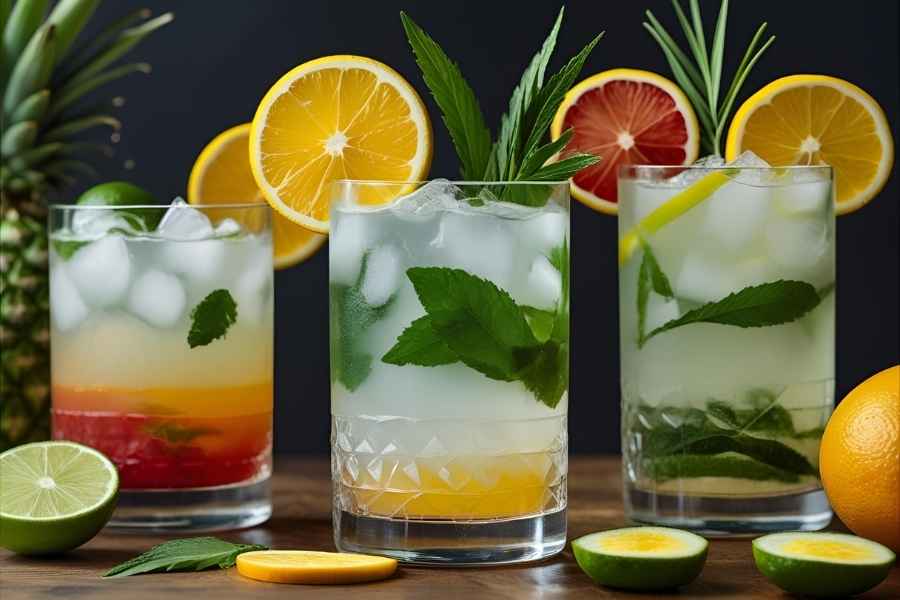
Proper garnishing elevates the Zombie from a simple mixed drink to an impressive cocktail worthy of special occasions. The visual presentation should reflect the drink’s tropical character while remaining functional and appealing.
Traditional Garnish Elements
Orange slices provide color contrast and aromatic enhancement. Choose oranges with vibrant color and fresh scent, cutting slices approximately ¼-inch thick for optimal visual impact. The orange oils released by the garnish contribute subtle flavor notes that complement the drink’s citrus components.
Maraschino cherries add sweetness and visual appeal. Use quality cherries that maintain their shape and color, avoiding overly artificial varieties that detract from the drink’s sophistication. The cherry should be firmly attached to prevent it from falling into the drink.
Pineapple wedges emphasize the drink’s tropical character while providing additional aromatics. Cut wedges from fresh pineapple when possible, ensuring they’re large enough to make a visual impact without overwhelming the glass.
Creative Garnish Options
Toasted coconut flakes can be rimmed the glass edge, adding texture and reinforcing the coconut rum’s flavor contribution. Toast the coconut lightly to enhance its flavor and create visual interest.
Lime wheels or twists provide additional citrus aromatics while maintaining the drink’s color scheme. Express the lime oils over the drink’s surface before adding the garnish to maximize aromatic impact.
Cocktail umbrellas, while somewhat cliché, remain popular for their ability to communicate the drink’s tropical theme instantly. Choose colors that complement the drink’s reddish hue without clashing.
Serving Occasions and Pairings

The Zombie’s strength and tropical character make it suitable for specific occasions and settings. Understanding when and how to serve this cocktail ensures maximum enjoyment and appropriate consumption.
Ideal Serving Situations
Tiki-themed parties provide the perfect backdrop for Zombie cocktails. The drink’s exotic character and potent reputation align perfectly with the escapist fantasy that defines tiki culture. Multiple Zombies with varying garnish arrangements create an impressive display that reinforces the party’s theme.
Summer poolside gatherings benefit from the Zombie’s tropical flavors and cooling effect. However, the drink’s strength requires careful monitoring in hot weather, as alcohol’s effects intensify with heat exposure and sun exposure.
Special celebrations and milestone events suit the Zombie’s impressive presentation and memorable character. The drink’s reputation creates conversation and shared experiences that enhance celebratory atmospheres.
Food Pairing Considerations
Spicy foods complement the Zombie’s fruit flavors while helping to moderate alcohol absorption. Thai, Caribbean, and Mexican cuisines work particularly well, as their bold flavors can stand up to the drink’s intensity.
Rich, fatty foods help slow alcohol absorption and provide necessary sustenance when consuming such potent cocktails. Coconut shrimp, fish tacos, and tropical fruit salads create harmonious flavor combinations.
Avoid pairing Zombies with light, delicate foods that would be overwhelmed by the drink’s intensity. Save subtle flavors for lighter cocktails that won’t compete for attention.
Safety and Consumption Guidelines

The Zombie’s reputation for potency isn’t just marketing—it’s a genuine safety concern that requires serious attention to responsible consumption practices. Each Zombie contains approximately three standard drinks’ worth of alcohol, making it equivalent to three separate cocktails consumed simultaneously.
Consumption Limits
Traditional tiki bars often limited customers to two Zombies per visit, and this guideline remains relevant for modern consumption. One Zombie should be considered sufficient for most people, particularly those unfamiliar with the drink’s effects.
The drink’s fruit flavors mask its alcohol content, making it easy to underestimate its potency. This deceptive drinkability has contributed to the Zombie’s notorious reputation and requires conscious effort to pace consumption appropriately.
Timing Considerations
Serve Zombies early in an evening’s festivities to allow time for their effects to diminish before guests need to travel. The drink’s strength makes it unsuitable as a nightcap or final cocktail of the evening.
Encourage food consumption alongside Zombies to slow alcohol absorption and provide necessary nutrients. The drink should never be consumed on an empty stomach due to its high alcohol content.
Alternative Approaches
Consider offering half-portion Zombies for guests who want to experience the drink without its full potency. This approach maintains the flavor profile while reducing alcohol content to more manageable levels.
Provide plenty of water and non-alcoholic alternatives to help guests pace themselves and stay hydrated. The tropical climate often associated with Zombie consumption increases dehydration risks.
Cost Analysis and Shopping Tips

Creating Zombies at home offers significant advantages over restaurant ordering, both financially and in terms of quality control. Understanding the economics helps justify the initial investment in ingredients while maximizing long-term value.
Ingredient Investment
The initial cost of purchasing all necessary ingredients ranges from $60-80, depending on spirit quality and local pricing. This investment pays for itself after making 6-8 drinks, compared to restaurant prices of $12-18 per Zombie.
Focus spending on quality rums, as they form the drink’s foundation. Mid-range options provide excellent results without the premium pricing of top-shelf spirits. Save money on mixers by purchasing larger containers and fresh fruit in season.
Bulk Purchasing Strategies
Buy spirits in 750ml bottles rather than smaller sizes for better per-ounce pricing. These bottles provide enough alcohol for 15-20 Zombies, making them economical for multiple occasions.
Purchase fruit juices in larger containers when planning multiple drinks, but be mindful of expiration dates. Fresh juices provide superior results but require more frequent shopping trips.
Storage and Preparation Tips
Proper ingredient storage and preparation techniques can streamline the Zombie-making process while maintaining quality standards. These strategies are particularly valuable when serving multiple drinks or hosting parties.
Ingredient Storage
Store opened fruit juices in the refrigerator and use them within their recommended timeframes. Pineapple and orange juices typically maintain quality for 5-7 days after opening, while cranberry juice lasts longer due to its natural acidity.
Keep rums at room temperature in a cool, dark place away from direct sunlight. Proper storage maintains flavor quality and prevents alcohol evaporation that can affect the drink’s strength and taste.
Advance Preparation
Pre-mix the fruit juice components and store them refrigerated for up to 24 hours before use. This technique saves time during service while ensuring consistent flavor ratios across multiple drinks.
Prepare garnishes in advance by cutting fruit and storing it properly covered in the refrigerator. Most garnishes maintain quality for 2-3 days when stored correctly.
Mastering the Perfect Zombie Experience
The Applebee’s Zombie represents more than just a cocktail recipe—it’s a gateway to understanding the rich tradition of tiki culture and the art of balanced cocktail creation. Mastering this drink requires respect for its potency, attention to ingredient quality, and commitment to responsible service practices.
Success with the Zombie comes from understanding that power and balance must coexist. The drink’s strength should never overshadow its tropical character, while its fruit flavors shouldn’t hide its alcoholic reality. This delicate balance separates excellent Zombies from merely strong drinks that happen to contain rum.
The investment in learning proper Zombie preparation pays dividends beyond cost savings. Understanding how multiple rums interact with fruit juices provides insights applicable to many other cocktails. The techniques learned while perfecting this recipe translate to improved bartending skills across the spectrum of mixed drinks.
Remember that the best Zombie is one consumed with full awareness of its strength and surrounded by friends who share your appreciation for expertly crafted cocktails. Take time to perfect your technique, source quality ingredients, and most importantly, never underestimate the power of this legendary drink. The Zombie’s reputation exists for good reason—respect it, and it will reward you with one of the most memorable cocktail experiences available.
